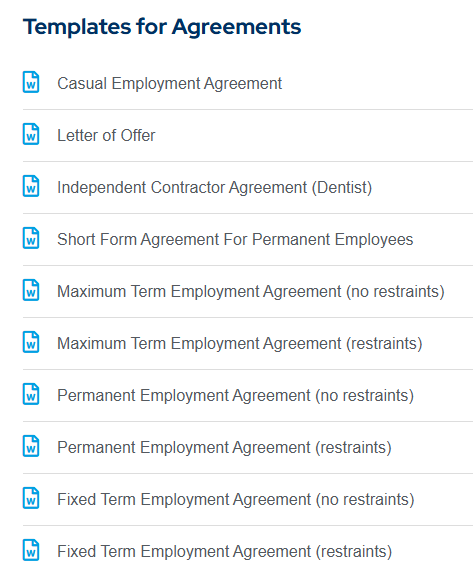Stop Risking It – Solid Employment Agreement Templates for Dental Teams
A clear and well-written employment agreement is key to creating a strong, professional, and legally sound working relationship in any practice. For years, many employers relied on verbal agreements or handwritten/typed letters when hiring team members. While this may have worked in simpler times, today’s workplace requires more clarity and protection for employers and employees.
The key to achieving this is customisable employment agreement templates designed to meet your practice’s specific needs—whether for permanent, casual, fixed-term, or contractor roles.
Employment agreements are legal documents that set the tone for a professional, trusting relationship. They clarify key points like job responsibilities, pay and entitlements, ensuring there is no room for misunderstandings.
Employment Agreement Templates
A dental employment agreement template outlines all the terms of employment, including roles, responsibilities, and benefits.
Benefit to Employers:
- Protect your practice by outlining clear terms of employment.
- Ensure compliance with Australian employment laws.
- Reduce the risk of disputes or confusion later down the line.
Benefit to Employees:
- Clearly defining their role, pay and entitlements.
- Ensuring fairness and transparency.
- Providing a reference point for expectations and workplace policies.
When both parties know exactly where they stand, it fosters trust, reduces uncertainty, and creates a more positive working environment.
Types of Dental Employment Agreement
Templates provided by Lync Dental are tailored to the different employment types common in dental practices:
1. Permanent Employment (Full-Time or Part-Time)
Permanent employees are ongoing team members who work full-time (38 hours per week) or part-time (less than 38 hours, with agreed-upon regular hours).
Agreements for permanent roles should include the following:
- Guaranteed weekly hours of work.
- Salary or hourly pay rates, including annual leave and superannuation entitlements.
- Job responsibilities and expectations tailored to positions
2. Casual Employment
Casual employees provide flexibility for both the practice and the employee. Although regular hours are not guaranteed, casuals are entitled to a higher pay rate (casual loading) to compensate for the lack of leave entitlements.
Custom agreements for casual roles ensure clarity on the following:
- Pay rates, including casual loading.
- Roster arrangements and notice periods.
- Role-specific expectations and conduct.
3. Fixed-Term Employment
Fixed-term contracts are ideal when hiring for a specific period, such as parental leave cover or special projects. Agreements for these roles should include:
- The start and end date of employment.
- Specific job responsibilities and goals during this time.
- Entitlements are applicable for the length of the contract.
4. Contractor Agreements
Independent contractors are engaged for specific services. Contractor agreements differ from employee contracts and need to include:
- Payment terms and invoicing arrangements
- Scope of work and services provided.
- Clear legal distinctions to avoid misclassifying contractors as employees.
Templates provided for Lync Premium Members
Understanding the National Employment Standards (NES)
The National Employment Standards (NES) set out the minimum entitlements for all employees covered by Australia’s Fair Work Act 2009. These standards apply regardless of whether an employee is full-time, part-time, or casual, covered by an Award or Award Free.
The NES covers:
- Maximum weekly hours of work.
- Annual leave, personal leave, and public holidays.
- Notice of termination and redundancy pay.
- Parental leave and compassionate leave.
While templates help ensure these entitlements are included, employers must understand the NES to maintain compliance and fairness.
Benefits for Employers and Employees
Customisable employment agreements offer practical benefits to both employers and employees.
For employers:
- Clarity on the role, responsibilities, and pay for each type of employment.
- Flexibility to adapt templates for specific needs, whether it’s a permanent, casual, or fixed-term role.
- A structured approach to onboarding, setting clear expectations from day one.
For employees:
A clear understanding of their role, pay, and entitlements. Protection against ambiguity, ensuring transparency and fairness. Confidence in their working arrangement, whether casual, permanent, or fixed term.
Agreement Time Frame
Can Employers Set a Deadline to Sign a Contract?
Employers can set a reasonable deadline for employees to review and sign an employment contract. However, this timeframe should allow employees sufficient opportunity to:
- Read the document thoroughly.
- Seek clarification on any terms they don’t understand.
- Obtain independent legal advice if they choose to.
Reasonable timeframes ensure the hiring process moves forward without placing undue pressure on the employee.
What Should an Employee Do If They Feel Pressured to Sign?
Employees who feel pressured to sign a contract quickly should:
- Request more time to review the agreement properly.
- Ask questions about any unclear terms.
- Seek independent legal advice to fully understand the implications of the contract.
A well-drafted employment agreement should benefit both parties and allow for informed decisions without pressure.
Lync Dental: Tailored Templates for Your Practice
We understand the challenges dental practices face when hiring team members. That’s why our Premium Membership provides access to employment agreement templates for permanent, casual, fixed-term, and contractor roles (see image). These templates are adaptable to your practice’s specific needs, helping you stay compliant, transparent, and efficient. Each template is carefully reviewed for accuracy and designed to reflect the unique nature of dental employment arrangements.
If you’re ready to start, check out our Premium Member Resources for templates, guides, and expert advice tailored to the dental industry.
Disclaimer
This article is for information purposes only and does not constitute legal advice. We recommend seeking professional legal advice to ensure your employment agreements meet Australian legal requirements and reflect your practice’s specific circumstances.







